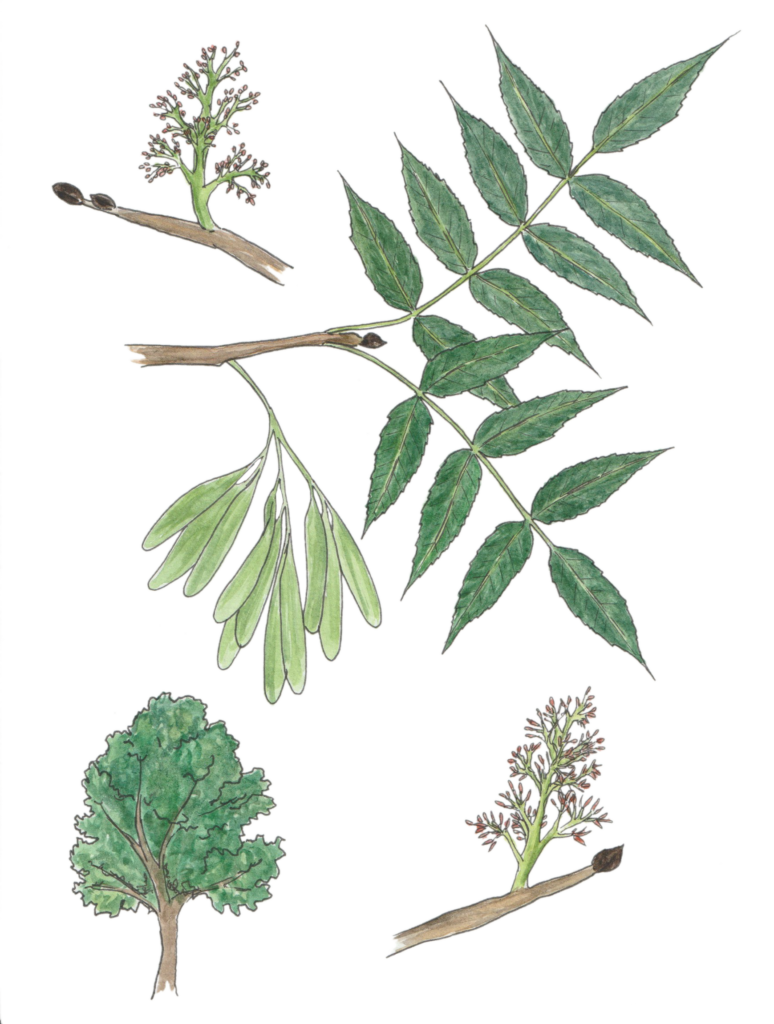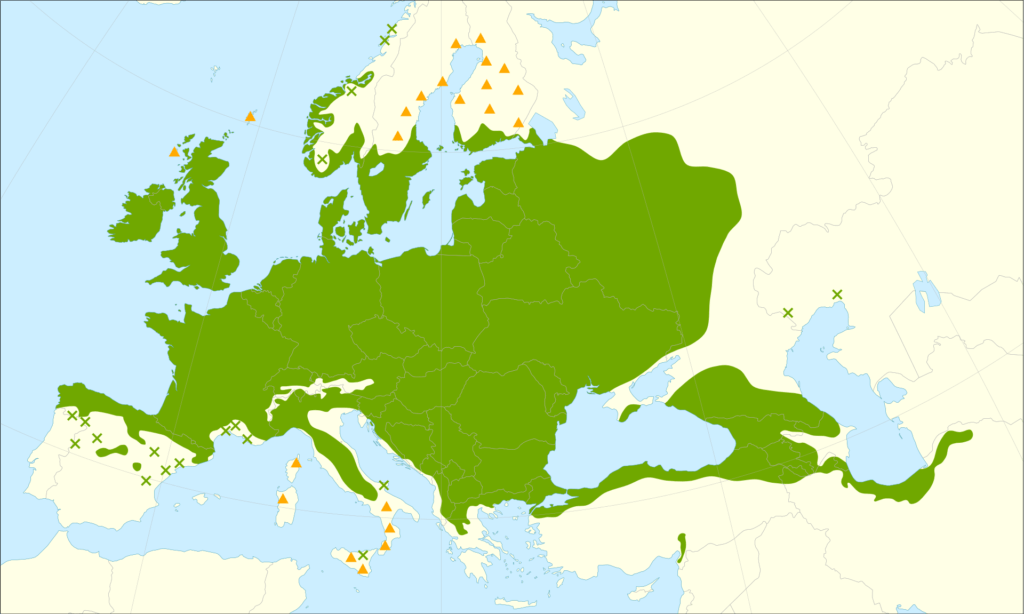Common ash – as the name suggests – should be common in our forests. In some habitats it used to be, indeed, quite common tree. But is this tree still SO Common? Regrettably, Not anymore.
Fraxinus excelsior
A Latin name for common ash, also called european ash. Fraxinus comes literally from a word “ash”. Excelsior means high. High, like in “highness”. Majesty. Grace. And yes these words seems to describe common ash perfectly. Ash can be 45 meters tall with 2 meters diameter. The trunk of the tree is usually straight and even. Very characteristic feature is dark, almost black and qutie big buds. One of my university professors used to say, it’s easy to recognize winter shoots when you compare it to tiny fragments of coal.

Common ash habitat requirements
F. excelsior is a native European deciduous tree. It occurs also in New Zaeland and United States, as a introduced species.
Ash tree requires humid habitats and very rich soils. It used to be common along the streams and around natural water reservoirs. You’ll read in the next part of an article, why I say “used to be”. While seedlings and young trees are shade tolerant, older trees are rather sun-demanding.
The distribution of Fraxinus exelsior is presented on the map below

Phytosociology and geobotany
Fraxino-Alnetum (W. Mat. 1952)
F. excelsior is one of two main tree species that form alder riparian forest (Fraxino-Alnetum after Fraxinus excelsior that is less common and more common Black Alder Alnus glutinosa). It’s a plant community widely distributed in Middle and East Europe: in eastern Germany, whole Poland, Lithuania, Latvia and Ukraine. It is a common community associated with slowly flowing waters.
Common ash also occurs as an important indicator in Alder-ash and willow communities (Carici remotae-Fraxinetum) and Ficario-Ulmetum minoris. It’s less common in Alnetum inacanae, Stellario nemorum-Alnetum (sometimes described as a category of Fraxino-Alnetum), Caltho-laetae-Alnetum, Violo odoratae-Ulmetum.
Extremely important tree in ancient beliefs
It’s one of the most beloved trees of our Ancestors (at least in Northern Hemisphere). Common ash plays a crucial role in many different beliefs and mythologies. It is, perhaps, the most important three in Scandinavian mythology. Yggdrasill, The Great Tree of The World, the tree whose crown covers the sky, and the roots of which the earth and the world have died, was indeed ash. Moreover, Scandinavian Gods made the first man on earth out of ash. Aescling, an old name of the Vikings, means The People of Ash tree. The Spear of Odin, Gungnir, was made, of course, of ash wood. F. excelsior was also important in Greek and Rome culture. More recently, Tolkien’s Gandalf the Grey had a staff made out of Ash wood.
Useful wood source
it is no coincidence that this wood was so important that it was supposed to form the spear of the god Odin. Back in history common ash wood was commonly used to make bows for hunting and, what was in the history in general much less important, for warfare. Why? Because it was a common tree in European broadleaf forests and is suitable for bowmaking. It’s not the very best wood for bows (the best wood species in this part of the world is actually less common English Yew (Taxus baccata), in this part of the World), but it is definitely good enough, somewhere between the best ones species for this purpose.
Nowadays common ash is, unfortunately, not as common as in the past centuries. At least at its native areas. Today the common ash population is significantly depleted. These trees were cut not only for the production of bows, but hard and useful wood was used widely for constructions, carpentry, furniture and many other purposes. The ash wood is resilient and its grain is usually even.

I personally love to work with ash wood. Wood is extremely pleasant to the touch and pleasant to work with with hand tools. Besides … it might be unusual, but ash wood smells great while working with it, believe me! 😉
Ash dieback
Today these majestic, beautiful and amazing trees suffer from a relatively new fungal disease called ash dieback (caused by fungi species Halara fraxinea) which causes them to weaken and, most often, die. Few old ash trees on the Old Continent have survived and are producing offspring. Foresters and scientists observe common ash populations and there is a chance, that the species will become more resistant to the disease over time and may become once again more common in forests.
A phenomenon known as natural selection means that due to the genetic variability of the population, some individuals develop with greater resistance to the disease. Some solid scientific research give a slight and shy glimmer of hope, that this situation will reverse and that ash will return to our forests in the future as a more common tree in Europe.
And I really hope so.
Chris
Literature
Chris Moliński, Waldemar, Przemysław Mania, and Gabriel Tomczuk. “The usefulness of different wood species for bow manufacturing.” (2016)
McKinney, L. V., et al. “The ash dieback crisis: genetic variation in resistance can prove a long‐term solution.” Plant Pathology 63.3 (2014): 485-499.
https://bsppjournals.onlinelibrary.wiley.com/doi/full/10.1111/ppa.12196
At the beginning, it was a Tree. Book by BAOBAB Publishing, multiple authors, Warsaw 2011. ISBN 987-83-89642-98-9
Caudullo, Giovanni, Erik Welk, and Jesús San-Miguel-Ayanz. “Chorological maps for the main European woody species.” Data in brief 12 (2017): 662-666.
Can you provide an example of a real-world application where binary trees are commonly used and explain their role in that context?
How can binary trees be used to efficiently store and retrieve data in a sorted manner?
What are the advantages and disadvantages of using a binary tree over other data structures for certain applications?
Can you explain the concept of tree traversal algorithms and how they are applied to binary trees?
What is a binary tree and how does it differ from other types of trees in data structures?